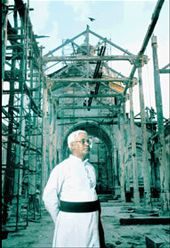 |
The 9th of July 2016 marks the 21st anniversary of the bombing of refugees in Navaly church which left at least 120 Tamil civilians dead.
The bombing of St Peters Church at Navaly, occurred following a series of leaflet drops in previous weeks that encouraged Tamil civilians to move to places of worship to avoid Sri Lanka’s air force bombing against the Liberation Tigers of Tamil Eelam. Initially, President Chandrika Kumaratunga’s government denied reports of the Church bombing before eventually pledging to establish an inquiry into the incident.
The Sri Lankan government initially criticised the International Committee of the Red Cross for reporting on the incident to the international community.
The ICRC, two days after the incident, reported,
“Thirteen babies were among the 65 dead found under the rubble of a Catholic church bombed by the Sri Lankan air force. According to eye witness accounts, this church and several adjacent buildings were hit by further air force strikes at 4.30 p.m. the same day. During the attack 65 people were killed and 150 wounded, including women and children. That evening and into the night Sri Lanka Red Cross staff evacuated most of the wounded by ambulance to the Jaffna Teaching Hospital. Delegates of the International Committee of the Red Cross (ICRC) present the next morning at the scene of the attack noted the widespread damage and measured the extent of the tragedy. Many of the bodies had not yet been removed from the rubble.”
Speaking to Time Magazine, the Bishop of Jaffna Thomas Savundaranayagam, who had already urged, President Kumaratunga to cease bombing of religious places of worship, said,
“The military warned civilians to clear the south west of its base at Palaly, recommending churches and temples as shelters. At 4.30 p.m. an Argentine made Pucara fighter flew toward the Navali church, 3 km outside the combat zone, and bombed the sanctuary and adjacent courtyard. St.Peters Church in Navali and the adjoining St.Peter's School where hundreds had sought shelter were badly gutted. 56 bodies were retrieved from the debris, many of whom were women and children. The final death toll in Navaly was about 120. Rescue workers have reported that torn limbs and pieces of human flesh were strewn over the area.”
A joint statement by 21 NGOs condemned the government’s killing of civilians.
"The Sri Lanka government, initially denied the bombing of the St.Peters Church. Then it criticised the ICRC representative for reporting the incident to the world media without consulting the Government. Later the government promised to hold an inquiry into the incident…The aerial bombardment of civilian population centres and places of worship follow a pattern set by the Sri Lanka armed forces over the past several years and President Kumaratunga's belated promise to investigate the recent violations, must ring hollow in the ears of the Tamil people whose kith and kin have lost their lives or their limbs in the bomb outrage.”
Pope John Paul, speaking a few days after the incident, expressed grief with those involved with the “ethnic conflict that is tearing Sri Lanka apart,” adding that he shared the grief “of those who lost their loved ones in the bombing of the church and school of Navaly.”
See more at Tamilnation.org.
‘I have no blood on my hands’ claims CBK (08 Jul 2015)
